Six ships of the Royal Navy have borne the name HMS Cossack, after the Cossack people of Eastern Europe, whilst another was begun but was cancelled while building:
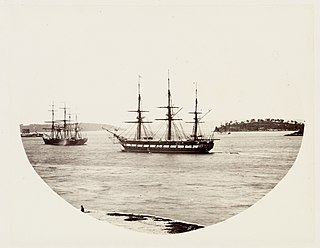
HMS Clio was a wooden 22-gun Pearl-class corvette, built at Sheerness Dockyard and launched on 28 August 1858. She was the flagship of the Australia Station between 3 September 1870 and 16 October 1873, and from 1876 was used as a school ship.
The siege of Taganrog is a name given in some Russian histories to Anglo-French naval operations in the Sea of Azov between June and November 1855 during the Crimean War. British and French forces were implementing a strategy of destroying the supply lines for the main Russian army which ran through the Sea of Azov. Taganrog was one of the major logistical hubs of the Russian army and was attacked and its military depot destroyed on 3 June 1855 as part of a series of attacks on all major Russian supply bases in the area, except Rostov-on-Don, which could not be reached due to the large shoals not admitting any available warship.

HMS Miranda was a 14-gun wooden screw sloop of the Royal Navy. As part of the 1847 Program, she was designed by John Fincham, Master Shipwright of Portsmouth ,and is considered an improved Rattler, with the design approved on 3 November 1847. She was ordered on 25 April 1847 with the name Grinder from Royal Dockyard, Sheerness. On 3 November 1847, she was reordered as Miranda from Sheerness Dockyard. Launched in 1851, she was completed to see action in the Crimean War. In 1854 she was in the White Sea and participated in the bombardment of the Port of Kola. She then served in the Sea of Azov during 1855. Two of her crew were awarded the Victoria Cross for their bravery. Towards the end of her career she transported troops during the New Zealand Wars. She was reclassified as a corvette by 1862. She was sold for breaking in December 1869.
HMS Highflyer was a 21-gun wooden screw frigate of the Royal Navy. She was built on the River Thames by C J Mare and launched on 13 August 1851. She spent twenty years in service, including action in the Crimean War and the Second Opium War, before being broken up at Portsmouth in May 1871.
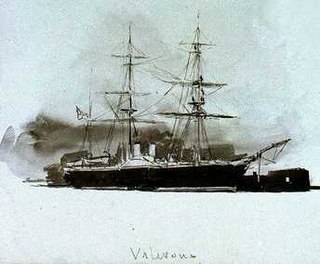
HMS Valorous was one of two 16-gun, steam-powered Magicienne-class second-class paddle frigates built for the Royal Navy in the 1850s. Commissioned in 1853 she played a small role in the Crimean War of 1854–1855 and was sold for scrap in 1891.
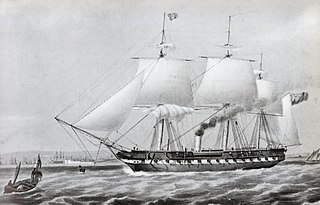
HMS Arrogant was an early wood screw frigate of the Royal Navy, launched in 1848 and sold in 1867. During the period of 1848–1850 she was commanded by Captain Robert FitzRoy.

HMS Harrier was a Royal Navy Cruizer-class screw sloop launched in 1854. She took part in the Crimean War, served on the Australia Station and took part in the New Zealand Wars. She was broken up in 1865
HMS Esk was a 21-gun Highflyer-class screw corvette launched on 12 June 1854 from J. Scott Russell & Co., Millwall. She saw action in the Crimean War, the Second Opium War and the Tauranga Campaign in New Zealand, and was broken up at Portsmouth in 1870.
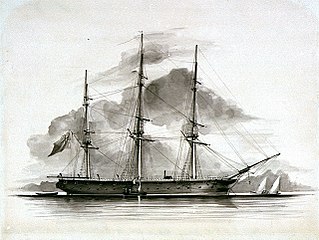
HMS Brisk was a 14-gun wooden-hulled screw sloop designed by the Committee of Reference as part of the 1847 program. She is considered an enlarged Rattler with the design approved in 1847. She was ordered on 25 April 1847 from Woolwich Dockyard as a 10-gun sloop, but the guns were later increased due to the Russian War, to 14 guns by increasing the number of 32-pounder guns. She was launched on 2 June 1851 from Woolwich Dockyard. She served in the Russian War of 1854- 55 and as part of the Southern African anti-slavery patrol, with a final commission on the Australian Station. She was sold in 1870 for use in an pioneer, but unsuccessful, telegraph service.

HMS Falcon was a 17-gun Royal Navy Cruizer-class sloop launched in 1854. She served in the Baltic Sea during the Crimean War and then in North America, West Africa and Australia. She was sold for breaking in 1869.
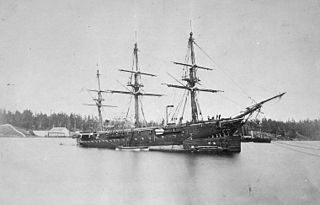
HMS Charybdis was a 21-gun Royal Navy Pearl-class corvette launched on 1 July 1859 at Chatham Dockyard.

HMS Blanche was a 1760-ton, 6-gun Eclipse-class wooden screw sloop built for the Royal Navy in the mid-1860s by Chatham Dockyard.
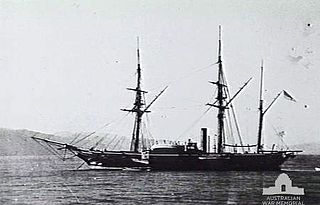
HMS Virago was a Royal Navy Driver-class wooden paddle sloop launched on 25 July 1842 from Chatham Dockyard.
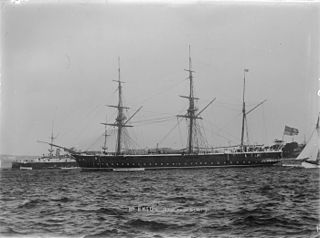
HMS Opal was an Emerald-class corvette of the Royal Navy, laid down as Magicienne by William Doxford & Sons Ltd, Sunderland and launched on 9 March 1875.

HMS Basilisk was a first-class paddle sloop of the Royal Navy, built at the Woolwich Dockyard and launched on 22 August 1848.

HMS Barracouta was the last paddle sloop built for the Royal Navy. She was built at Pembroke Dockyard and launched in 1851. She served in the Pacific theatre of the Crimean War, in the Second Opium War and in the Anglo-Ashanti wars. She paid off for the last time in 1877 and was broken up in 1881.
Sir William Alexander George Young, , was a British colonial administrator who acted in an interim capacity as Governor of Jamaica in 1874, and later served as Governor of Gold Coast from 1884 to his death in 1885. His father may have been an RN paymaster as well: a paymaster of that name was on board HMS Gorgon when she ran aground on the River Plate in May 1844 and was refloated in November that year.

The Cossack-class corvettes were two 20-gun first-class corvettes, initially under construction in Britain for the Imperial Russian Navy. These ships were seized on 5 April 1854, after the outbreak of the Crimean War.

HMS Tartar was a wooden screw corvette of the Royal Navy. Originally built for the Russian Empire, she was seized by British forces on 5 April 1854, shortly before her launch.















